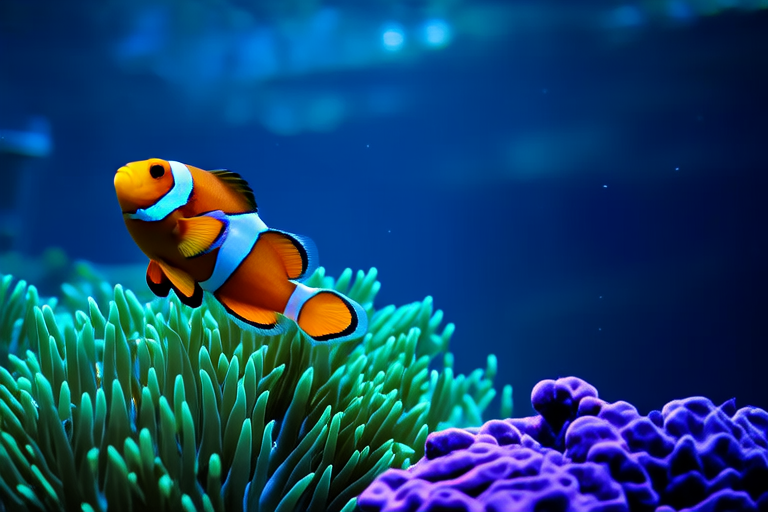From Pixar to Your Tank: The Real Life of a Clownfish
The clownfish, with its vibrant orange color and distinct white stripes, has captured the hearts of millions since its portrayal as Nemo in Pixar’s hit film “Finding Nemo.” This iconic fish has become more than just a character in a movie; it has sparked a global fascination with marine life, particularly among aquarium enthusiasts. While the film might have romanticized the clownfish’s life, this article delves into the realities of their existence, both in the wild and in captivity.
The Popularity of Clownfish
Before diving into the details of clownfish, let’s explore why they’ve become such popular pets. “Finding Nemo” brought these fish into the spotlight, making them household names and increasing their appeal to aquarists. The movie’s charming narrative about a father searching for his lost son resonated deeply with audiences, leading to a surge in interest in these small, charismatic creatures. As a result, many people are now curious about bringing a piece of the ocean into their homes, aspiring to recreate the magical underwater world seen on screen.
Natural Habitat and Behavior
Clownfish are native to the warm waters of the Pacific and Indian Oceans, particularly around coral reefs. These regions provide an ideal environment for them, characterized by rich biodiversity and complex ecosystems. In their natural habitat, clownfish live in symbiotic relationships with sea anemones. The anemone provides protection from predators, while the clownfish helps to attract food for the anemone through its movements and waste products.
Behaviorally, clownfish are known for their territorial nature and strong swimming abilities. They are generally peaceful but will fiercely defend their territory against intruders. Their agility allows them to navigate the intricate reef structures with ease, darting in and out of crevices to avoid danger. In the wild, they can be found in groups, often led by the largest and most dominant female, who is also the only one that reproduces within the group.
Diet and Feeding Habits
In the wild, clownfish are omnivores, feeding on a variety of foods. Their diet primarily consists of algae, zooplankton, and small crustaceans. This diverse diet ensures they get all the necessary nutrients for growth and survival. However, in captivity, it is crucial to replicate this diet as closely as possible to maintain their health. A balanced diet for captive clownfish should include a mix of flake food, frozen foods like brine shrimp or mysis shrimp, and occasional vegetable matter.
Challenges and Considerations of Keeping Clownfish
Bringing a clownfish into your home aquarium comes with its own set of challenges and considerations. One of the primary concerns is the tank setup. Clownfish require a well-established tank with plenty of hiding spots and ample swimming space. A minimum tank size of 30 gallons is recommended for a single clownfish, though larger tanks are preferable if you plan to house multiple clownfish or other species.
Water conditions are another critical factor. Clownfish thrive in slightly acidic water with a pH level between 7.8 and 8.4. Maintaining stable water parameters is essential for their well-being. Regular testing and timely water changes are necessary to ensure optimal conditions. Additionally, clownfish prefer warmer water temperatures, ideally ranging from 76°F to 82°F (24°C to 28°C).
Selecting compatible tank mates is equally important. Clownfish can coexist with various species, provided there is enough space and resources for everyone. Some good tank mates include non-aggressive species like damselfish, tangs, and some wrasses. However, caution should be exercised when introducing new fish to prevent stress or aggression.
Tips for Ensuring Health and Happiness
To ensure the health and happiness of clownfish in captivity, several tips should be followed. First, acclimate them slowly to their new environment. Rapid changes in water parameters can shock the fish, leading to stress and illness. Gradually introduce them to the tank over several hours by floating the bag in the tank water and periodically adding small amounts of tank water to the bag.
Regular maintenance is key to keeping the tank clean and healthy. This includes regular water changes, proper filtration, and monitoring of water quality. Providing a varied diet also contributes to their overall health. Offering different types of food ensures they receive all the necessary nutrients.
Lastly, observe their behavior regularly. Healthy clownfish are active and curious, exploring their surroundings and interacting with their tank mates. Any signs of lethargy, loss of appetite, or abnormal behavior should prompt immediate action. Consulting with a veterinarian specializing in aquatic animals can help diagnose and treat any issues early.
Conclusion
From Pixar’s “Finding Nemo” to your home aquarium, the clownfish has come a long way. Understanding their natural habitat, behavior, and dietary needs is crucial for providing them with a happy and healthy life in captivity. By setting up the right tank environment, maintaining optimal water conditions, and selecting compatible tank mates, you can ensure that your clownfish thrives. Responsible pet ownership means being committed to the care and well-being of your aquatic friends, ensuring they lead fulfilling lives in their new homes.
